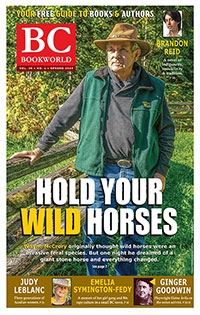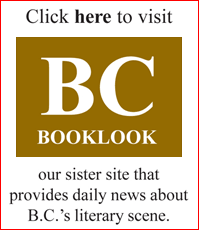BOOKS: (with Richard Cannings)
Birds of the Okanagan Valley, British Columbia (Royal BC Museum, 1987). With Robert Cannings.
British Columbia: A Natural History (Greystone, 1996; revised 2004; revised 2014)
World of Fresh Water (Greystone, 1998)
Mountains and Northern Forests (Greystone, 1998)
Life in the Pacific Ocean (Greystone, 1999)
The Geology of British Columbia (Greystone, 1999). Geology of British Columbia: A Journey through Time; with Sydney Cannings and Joanne Nelson (Greystone Books 2011) 978-1-55365-815-3 $24.95
The B.C. Roadside Naturalist (D&M, 2002) 1-55054-902-2
The New B.C. Roadside Naturalist: A Guide to Nature Along B.C. Highways (Greystone Books, 2015) $22.95 9781771000550
[See Richard Cannings entry for additional info.]
[BCBW 2015]
Birds of the Okanagan Valley, British Columbia (Royal BC Museum, 1987). With Robert Cannings.
British Columbia: A Natural History (Greystone, 1996; revised 2004; revised 2014)
World of Fresh Water (Greystone, 1998)
Mountains and Northern Forests (Greystone, 1998)
Life in the Pacific Ocean (Greystone, 1999)
The Geology of British Columbia (Greystone, 1999). Geology of British Columbia: A Journey through Time; with Sydney Cannings and Joanne Nelson (Greystone Books 2011) 978-1-55365-815-3 $24.95
The B.C. Roadside Naturalist (D&M, 2002) 1-55054-902-2
The New B.C. Roadside Naturalist: A Guide to Nature Along B.C. Highways (Greystone Books, 2015) $22.95 9781771000550
[See Richard Cannings entry for additional info.]
[BCBW 2015]
Articles: 1 Article for this author
Columbia: A Natural History (Greystone $45)
Article
When meeting identical twins Syd & Dick Cannings you're forgiven for losing track of who's who.
If one begins performing bird calls, chances are it's Dick. If one speaks passionately about bugs, well, that's Syd. Nine times out of 10 anyway. The brothers were reared in the Okanagan Valley in a family that embraced the outdoors. "We took the natural world for granted then,"; they write. "It was literally our back yard.";
Dick grew up to become a biologist and curator of the Cowan Vertebrate Museum at the University of B.C. with a special interest in birds. These days he's a consulting biologist based in Naramata. Syd followed the buggier path to become a zoologist and curator of the Spencer Entomological Museum at UBC. He works as a provincial government zoologist.
Their collaborative British Columbia: A Natural History (Greystone $45) has the feel of a nature walk with two gracious and exciting experts leading the expedition.
The Cannings stick to what they know - consequently the Far North isn't covered - but what's left is remarkable in scope. Transported from ocean floor to mountain top, we're exposed to a veritable Noah's Ark of plants and animals.
Most British Columbians realize the province has the most diverse geography in the country, but many may be surprised to discover we are also home to more species of living things than any other province - some 35,000 species of insects alone.
There are also significant world populations; 60 per cent of the planet's mountain goats and 25 per cent of all grizzly bears live in this biological paradise.
The first chapters of this book speak to the province's origins, before there was even land mass. "Two hundred million years ago there was no British Columbia - at least there was no British Columbia west of the present Rocky Mountains.";
Through generous use of photographs, drawings and maps the Cannings explain how today's physical environment emerged from massive collisions of tectonic plates and magma eruptions. The resulting landscape became the foundation for life.
Seven ecosystems - from Pacific to Montane Forests and Grasslands - are explored and punctuated by fascinating and sometimes amusing facts. The Cannings can't resist a playful interpretation of Barnacle sex.
"Sex in the animal kingdom doesn't get much stranger than between barnacles - hermaphroditic crustaceans locked in shells, standing upside down with their heads glued to the rocks. How do they do it? With a penis 20 times longer than their body!";
There are also polygamist Northern Saw whet Owls that seek multiple partners, Flying Squirrels that dine on fungi, and Clark's Nutcrackers with memories that put grad students to shame. These birds can cache up to 100,000 Whitebark Pine seeds and find most of them again.
This book allows us to travel without leaving home, to places like Triangle Island. The most remote island in B.C. is 50 kilometres west of the northern tip of Vancouver Island and is home to over a million seabirds including the Tufted Puffin that graces the cover of the book. Its exotic appearance suggests it just flew in from Galapagos, but in fact 30,000 pairs winter on the open ocean hundreds of kilometres from Triangle Island. They return each year to renew the cycle of life.
The fine balance of life, and man's tinkering is never far from view. The Cannings decry experiments that don't take into consideration the impact on resident populations, and the consequences of irresponsible resource extraction.
"We have the whole world in our hands,"; they write. "And in our small corner of the globe we hold the future in our hands. We hold the future of the kelp forests and eel grass beds... the eagles and seaducks drawn to spawning herring... let's not let them go.";
British Columbia: A Natural History is a welcome extension of Syd and Dick's keen curiosity born in the fields of the South Okanagan, and their profound understanding of the inter connectedness of all things.
[BCBW 1997]
 Home
Home




